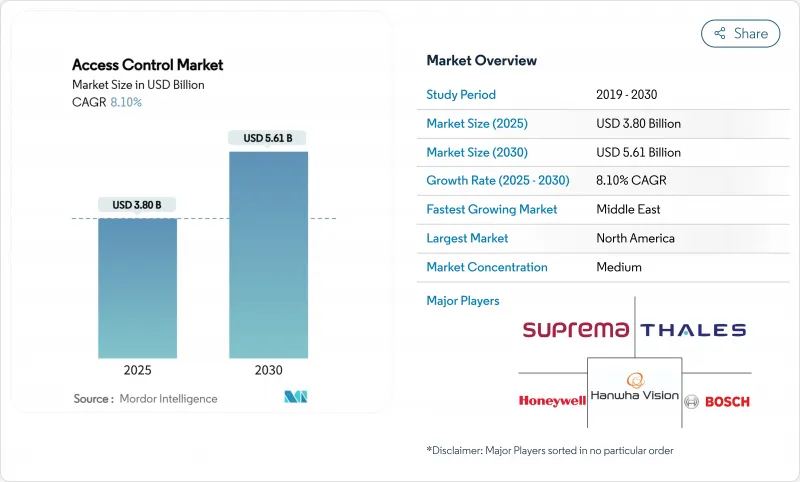
|
市場調査レポート
商品コード
1851497
アクセスコントロール:市場シェア分析、産業動向、統計、成長予測(2025年~2030年)Access Control - Market Share Analysis, Industry Trends & Statistics, Growth Forecasts (2025 - 2030) |
||||||
カスタマイズ可能
適宜更新あり
|
|||||||
| アクセスコントロール:市場シェア分析、産業動向、統計、成長予測(2025年~2030年) |
|
出版日: 2025年07月11日
発行: Mordor Intelligence
ページ情報: 英文 150 Pages
納期: 2~3営業日
|
概要
アクセスコントロール市場規模は2025年に38億米ドル、2030年には56億1,000万米ドルに達すると予測され、予測期間中のCAGRは8.10%を記録します。

企業、公共機関、重要インフラ施設において、クラウド管理、モバイル認証情報、バイオメトリクスが従来のキーやカードに取って代わるにつれ、需要は激化しています。データ保護規制の強化、非接触型ユーザーエクスペリエンスの重視、ビデオ監視との融合により、アップグレードサイクルが強化されています。半導体不足に関連した価格高騰は、サプライチェーンリスクを軽減しつつ、資本支出を将来にわたって保証するソフトウェア定義アーキテクチャへと買い手を誘導しています。
世界のアクセスコントロール市場の動向と洞察
GDPRの影響を受けやすいEUのデータセンターにおける電子アクセスの規制強化
2024年10月発効のNIS2指令では、すべての物理的エントリポイントにおいて多要素認証と耐タンパー性の監査証跡が要求されています。データセンター事業者は、暗号化と継続監視条項を満たすため、従来のカードからバイオメトリクス認証やモバイル認証への移行を加速させています。ベンダーのサプライチェーン監視は調達のしきい値を引き上げ、自動化されたコンプライアンス・レポートを提供するプラットフォームへの需要に舵を切っています。NIS2とGDPRの相乗効果により、物理的セキュリティを実施しながら個人データを保護する統合ソリューションに対するプレミアムが生まれ、アクセスコントロール市場全体の交換予算が増加します。
北米の企業不動産における非接触型モバイル・クレデンシャルの普及
商業施設の大家は、改札口やエレベーター、スイートルームのロックを解除するApple WalletやGoogle Payのクレデンシャルを発行しています。遠隔プロビジョニングはバッジ発行コストを削減し、柔軟な座席ポリシーをサポートします。暗号化された無線アップデートにより、施設チームは紛失した携帯電話を即座に無効化し、入居者の利便性を高めながらセキュリティを強化することができます。既存のスマートフォン・インフラストラクチャと互換性があるため、カードプリンターのオーバーヘッドがなくなり、ビジネスケースが強化されます。迅速な導入サイクルは、業務効率の目に見える向上につながり、アクセスコントロール市場の勢いをさらに強めています。
EUクラウド展開におけるサイバーセキュリティ・コンプライアンスコスト(NIS2)
クラウドホスト型アクセスプラットフォームは、NIS2を満たすために、継続的な脅威監視、安全なコード署名、文書化された開発パイプラインを追加する必要があり、ベンダーの運用コストを15~20%押し上げます。小規模なプロバイダーは監査費用や侵入テストの費用を吸収するのに苦労しており、買い手が認証されたインフラを持つグローバルブランドに引き寄せられるように統合が進みます。一部のEU企業はアップグレードを延期し、リプレースサイクルを引き延ばしており、アクセスコントロール市場の成長見通しをわずかに弱めています。
セグメント分析
物理的配置における電子ロック、コントローラー、バイオメトリック・リーダーの必要性を反映して、ハードウェアが62.1%のシェアで2024年の売上を牽引しました。大学の改修だけでも、キャンパスがモバイル対応インフラに移行するにつれて、ロックの更新サイクルが大幅に増加しました。電子ロックは、ハンズフリー入場を可能にするウルトラワイドバンドモジュールが原動力となり、最も急速に台数を伸ばしました。バイオメトリクス・マルチセンサー・リーダーは、高い保証の検証を必要とする研究所や薬局で支持を得た。
ソフトウェアは2030年までCAGR 9.1%で成長し、管理コンソールに予測分析とAI主導の異常検知を追加します。クラウド・コントロール・プレーンは異なるサイトを統合し、リアルタイムのポリシー・プッシュと自動コンプライアンス監査を可能にします。ダッシュボード内のビデオアクセスの統合は調査能力を強化し、オープンAPIはエコシステムの開発を促します。統合サービスと定期サポート契約はパートナーの収益を拡大し、マネージド・サービスをアクセスコントロール業界における回復力のある年金層として位置づける。
ホスティング型ACaaSは、2024年の導入の52.3%を占め、サーバー所有よりも予測可能なサブスクリプションを好む中小企業に牽引されています。オンプレミスのソリューションと同等の機能と自動アップデートにより、IT部門のスキル負担を軽減。きめ細かなテナント・ポータルは、コワーキング・ブランドが数千人のメンバーを動的に管理するのに役立ち、アクセスコントロール市場における顧客ロイヤルティを高める。
ハイブリッドACaaSはCAGR 8.8%で最も急成長しているモデルであり、クラウド・オーケストレーションとローカル・エッジ・ストレージのバランスを取り、規制対象企業向けに提供されています。病院では、ネットワークが停止している間、機密性の高いログをオンサイトのアプライアンスにルーティングし、接続が回復すると分析のためにクラウドに同期します。マネージドACaaSは、特注の統合を必要とする複雑なマルチベンダーエステート向けのニッチを維持しているが、プラットフォームは、より広いアクセスコントロール市場において、セクターを超えて拡張するセルフサービスパラダイムへと着実に収束しています。
アクセスコントロール市場は、コンポーネント別(ハードウェア、ソフトウェア、サービス)、アカアス展開別(ホスティング、マネージド、ハイブリッド)、認証方式別(シングルファクター、マルチファクター、モバイルクレデンシャル)、接続技術別(RFID/NFC、スマートカード、Bluetooth LE、UWB)、エンドユーザー業界別(商業、産業、政府、その他)、地域別に分類されています。市場予測は金額(米ドル)で提供されます。
地域別分析
北米は、企業キャンパス、大学、病院における大規模な近代化に支えられ、2024年の売上シェア38.9%を維持。ケンタッキー大学の9,000ドア化など米国の高等教育機関の改修は、アクセスコントロールと出席分析を融合させたモバイル対応プラットフォームのキャンパス全体への導入を示しています。カナダのスマートビルディング奨励策やメキシコの国境を越えた物流施設は、さらに需要を増やしています。UWBとバイオメトリックの新興企業へのベンチャー投資により、この地域はアクセスコントロール市場の技術革新の最前線に位置しています。
中東は、2030年までのCAGRが9.6%と最も急成長している地域であり、スマートシティ構想とセキュリティ優先の規制枠組みが後押ししています。UAEとサウジアラビアは物理的IDに代わる顔認証、虹彩認証、指紋認証システムを大規模に展開し、カタールとオマーンはアクセスコントロールを全国的なIoTコマンドセンターに組み込んでいます。現地のインテグレーターはグローバルベンダーのSDKをベースに地域固有のソリューションを構築し、市場のローカライズを加速させています。
欧州は、厳しいプライバシー法にもかかわらず、着実な成長を示しています。NIS2とEUのAI法は、バイオメトリックの使用について明示的な同意と透明性を要求しています。組織は、ハイブリッドACaaSを採用することで、機密性の高いバイオメトリック・テンプレートを欧州に残すことで対応しています。ドイツ、フランス、英国はベンダーのロックインを避けるためにオープンプロトコルのシステムを優先し、北欧の事業者は持続可能な低消費電力リーダーを開拓しています。東欧の交通機関ハブは、カードベースのバリアをモバイルやビデオ認証入場でアップグレードし、アクセスコントロール市場の収益増に貢献しています。
その他の特典:
- エクセル形式の市場予測(ME)シート
- 3ヶ月間のアナリストサポート
よくあるご質問
目次
第1章 イントロダクション
- 調査の前提条件と市場の定義
- 調査範囲
第2章 調査手法
第3章 エグゼクティブサマリー
第4章 市場情勢
- 市場概要
- 市場促進要因
- GDPRの影響を受けやすいEUのデータセンターにおける電子アクセスに関する規制の義務化
- 北米の企業不動産における非接触型モバイル・クレデンシャルの普及
- スマートシティと重要インフラ・プログラムが中東のバイオメトリクスを後押し
- APACにおけるコワーキングスペースの拡大がクラウドベースのACaaSを牽引
- IPビデオアクセスコントロール欧州交通ハブにおけるコンバージェンス・アップグレード
- 米国高等教育機関における老朽化したキーカード・システムの改修需要
- 市場抑制要因
- EUのクラウド導入におけるサイバーセキュリティ対応コスト(NIS2)
- セキュアMCUチップ不足がリーダー出荷に影響
- 米国とEU諸国における顔認証に対するプライバシー保護の反発
- 南米における中小企業の予算制約
- サプライチェーン分析
- 技術スナップショット(進化、RFID vs NFC、主要動向)
- 規制とテクノロジーの展望
- ポーターのファイブフォース
- 供給企業の交渉力
- 買い手の交渉力
- 新規参入業者の脅威
- 競争企業間の敵対関係
- 代替品の脅威
- 投資と資金調達分析
第5章 市場規模と成長予測
- コンポーネント別
- ハードウェア
- カード/近接/スマートカードリーダー
- バイオメトリクスリーダー(指紋、顔、虹彩、マルチモーダル)
- 電子ロック(マグネット、電気ストライク、デッドボルト、ワイヤレススマートロック)
- コントローラとパネル
- ソフトウェア
- アクセスコントロール管理スイート
- ビデオ管理統合プラグイン
- サービス
- 設置および統合
- サポートとメンテナンス
- ハードウェア
- Access Control-as-a-Service(展開)別
- ホスト型ACaaS
- マネージドACaaS
- ハイブリッドACaaS
- 認証方式別
- シングルファクター認証
- 多要素認証
- モバイルクレデンシャル/Bluetooth LE
- 通信技術別
- RFID/NFC
- スマートカード(125 kHz、13.56 MHz)
- Bluetooth低エネルギー
- 超広帯域(UWB)
- エンドユーザー業界別
- 商業ビル
- 産業および製造
- 政府および公共部門
- 輸送・物流
- ヘルスケア施設
- 軍事・防衛施設
- 住宅およびスマートホーム
- 地域別
- 北米
- 米国
- カナダ
- メキシコ
- 南米
- ブラジル
- アルゼンチン
- その他南米
- 欧州
- 英国
- ドイツ
- フランス
- イタリア
- スペイン
- その他欧州地域
- アジア太平洋地域
- 中国
- 日本
- インド
- 韓国
- ASEAN
- オーストラリア
- ニュージーランド
- その他アジア太平洋地域
- 中東・アフリカ
- 中東
- GCC
- トルコ
- イスラエル
- その他中東
- アフリカ
- 南アフリカ
- ナイジェリア
- エジプト
- その他アフリカ
- 北米
第6章 競合情勢
- 市場集中度
- 戦略的な動き(M&A、パートナーシップ、製品発表)
- 市場シェア分析
- 企業プロファイル
- ASSA ABLOY AB
- Johnson Controls International plc(Tyco)
- Honeywell International Inc.
- Dormakaba Holding AG
- Allegion plc
- Bosch Security Systems Inc.
- Thales Group(Gemalto)
- Suprema Inc.
- Hanwha Vision Co. Ltd.
- Schneider Electric SE
- NEC Corporation
- Idemia Group
- Nedap N.V.
- Axis Communications AB
- Panasonic Connect Co. Ltd.
- Brivo Systems LLC
- Identiv Inc.
- Salto Systems S.L.
- Siemens Smart Infrastructure
- Genetec Inc.

